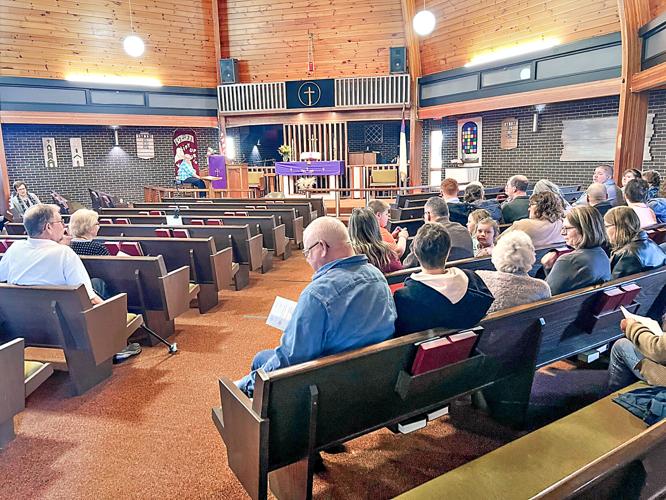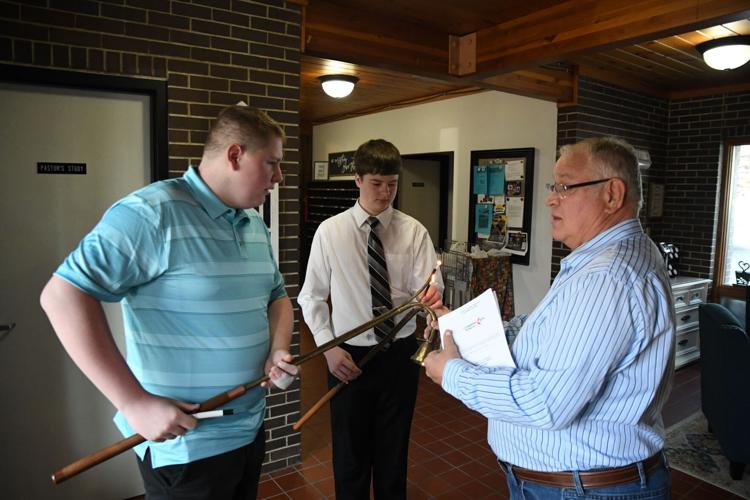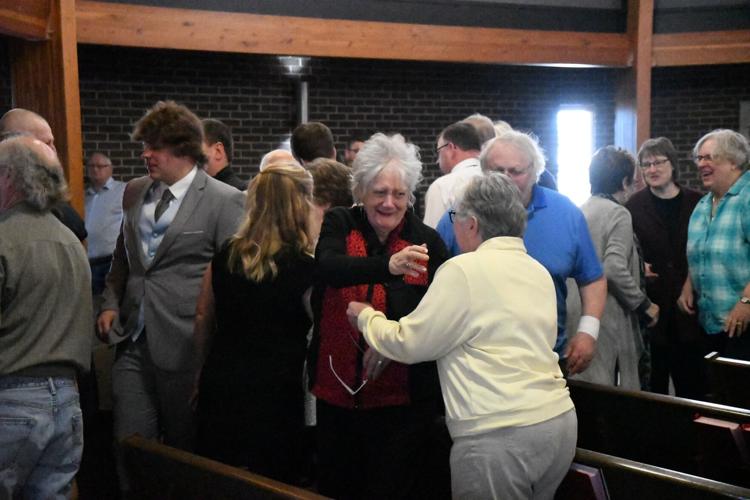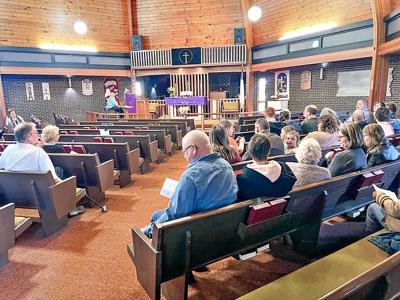REGIONAL—On a Sunday early this spring, the sanctuary of St. Andrew’s United Methodist Church in Sanborn was filled with stained-glass light. Congregants chatted quietly in the vestibule before making their way inside, filing into wooden pews. At the front of the church, a pianist played a hymn.
That morning, the church, a small parish that until recently had grown smaller still, slowly filled with worshippers.
Just weeks earlier, the scene would have been different. Interim pastor Kris Lien of Sheldon had grown to expect regular Sunday crowds of fewer than 20; however, that number doubled in February, and today, the pews at St. Andrew’s, while not exactly full, are bustling with a new kind of life.
“I was kind of used to 12, 15 people, and then one Sunday, all of the sudden like 20 people walked in from Sheldon, and I knew most of them,” Lien said. “They were just like, ‘Yeah, you know, we’re just looking for a place.’”
In one way of looking at it, the newcomers to St. Andrew’s United Methodist Church are a sign that turmoil in the church’s global denomination has reached N’West Iowa. The Sheldon group started coming to Sanborn after their church, Sheldon United Methodist Church, voted to leave its historic denomination last October. Other UMC churches across the country have done the same, reflecting deepening division in the denomination. Among other matters of biblical interpretation, questions related to human sexuality have been major sticking points. The Sheldon vote, which passed by more than the required two-thirds majority, left many of those opposed to leaving broken and reeling.

Acolytes Jacob Roelff and Luke Dagel light candles with the help of Rodney Rath before walking into the sanctuary of St. Andrew’s United Methodist Church in Sanborn. Each Sunday, acolytes are designated to help light the candles at the altar during the Sunday morning worship service.
“I went to Sunday School there, and I got married there. My son was baptized there, and my dad was buried from there,” said 67-year-old Mary Wallinga. “So, the building itself has a lot of memory. When this all took place this summer, I could hardly believe that it would ever happen.”
As of last fall, she had attended the church for 64 years. Wallinga now attends St. Andrew’s in Sanborn, making the drive each Sunday with her husband, Warren.
Until the vote, 69-year-old Barb Burns had faithfully attended Sheldon United Methodist Church for 34 years. An active member of the congregation, she raised her four children in the church, and she often played the organ on Sundays.
After the vote, she and her husband, Darrell, decided to look for a new church home.
“I felt like I was grieving for a family member. The church that I had known and loved was no longer there,” Barb said. “It’s always going to be the church that I loved — it’s always going to be a part of my heart. But you have to just let it go — because it’s not there anymore.”
Sixty-nine-year-old Juanita Thaden is another of the former Sheldon parishioners making the drive each Sunday to Sanborn, and like Barb, she said she has always appreciated her denomination’s “big tent,” which was wide enough to cover a diversity of theological and political opinions.
“I just love the fact that there’s always a church home for anyone who wants a church home,” she said. “You don’t have to worry about somebody being offensive. You just come. They meet you where you are.”
“It used to be known, ‘Anybody can be a Methodist,’” said 71-year-old Darrell Burns.
“That’s a positive — because that’s what the church should be, right?” Barb Burns said.
“I was born and raised Baptist, and my first marriage was Catholic,” Darrell said. “Like I said, anybody could be a Methodist.”
“A divorced Catholic — they even took him,” Barb said, laughing.
Sometime this summer, Sheldon United Methodist Church, which celebrated its sesquicentennial last year, will remove the UMC logo from its signage, choose a new name and move into a new future.
To stay
It is not a new American story: Mainline Protestantism is in decline. Faith, in general, is in decline, and the numbers of the religiously unaffiliated continue to rise. Still, amid decline, and at odds with the dissent fracturing many denominations, there are small bursts of renewal — tiny signs of hope that, for the community of the faithful, point to a God still at work among a stumbling and wayward people.
Lien sees the unexpected influx of new parishioners as just that sort of hopeful beacon, though the story that led to their coming is a painful one, and it reflects the turmoil roiling in some of the county’s oldest and largest denominations.

Parishioners of St. Andrew’s United Methodist Church in Sanborn gather each Sunday for worship. Recently, the church doubled in size after worshippers from Sheldon began attending the nearby church.
In one of the earliest sermons Lien preached to his newly expanded congregation, he originally planned to tackle questions related to human sexuality — Lien himself emphasizes God’s grace and hospitality, but he holds to a traditional view of marriage. However, when he learned another handful of Sheldon parishioners would be in the pews on Valentine’s Day, he changed his plan.
“Instead, I preached on, ‘How do we stay united in a divided world?’” he said. “I had a number of them come up afterward, and they’re crying, and they’re like, ‘That is so refreshing that we can agree to disagree, but we can still worship together.’”
The United Methodist Church was formed through a union of the Methodist Church and the Evangelical United Brethren Church in 1968, but its roots in a Wesleyan theological tradition go much deeper. Those roots were planted in early American soil by itinerant preachers, called circuit riders, who spread the Methodist movement westward over the course of the 19th century, following John Wesley’s 1784 commissioning of the first Methodist Church in the United States. At the heart of the tradition, which grew out of the writings and teachings of Wesley, an 18th-century Anglican priest, is a commitment to personal piety and earnest acts of social service. Today, the UMC is the second-largest Protestant denomination in the United States, numbering 6.4 million U.S. members and 13 million worldwide, and it is among the latest Protestant denominations to splinter along political and theological lines.
Regional turmoil
In the last several years, the fractious remaking of Protestantism in N’West Iowa has been most visible in two denominations: the UMC and the Reformed Church in America, a relatively small Protestant denomination that is one of America’s oldest. Historically, the RCA was tied to a Dutch ethnic identity, and unlike the geographically dispersed UMC, the RCA is concentrated in California, Illinois, Iowa, Michigan, New Jersey and New York.

Parishioners of St. Andrew’s United Methodist Church in Sanborn gather each Sunday for worship. Recently, the church doubled in size after worshippers from Sheldon began attending the nearby church.
The shifts in both the RCA and UMC reflect decades of internal turmoil, with conservative factions drifting further to the right, and liberal factions further to the left, each camp consolidating their political and theological positions on different ends of the spectrum of belief. The disagreements run deep, and touch on fundamental questions related to biblical revelation and interpretation. However, front and center of these debates are questions related to human sexuality.
The Rev. Elizabeth Hardeman, who recently accepted a call to Second Reformed Church in Pella, spent eight years as co-pastor of Orange City’s American Reformed Church, one of only a handful of churches in the county who have remained in the RCA.
“What we’ve seen over the last decade or so is a continual push to polarize and to pick — to choose. To decide. And then to sort of silo up with those who have picked and chosen and decided like we have as individuals — whether that’s a political issue, a social issue, a religious issue, or the interweaving of all of those,” Hardeman said.
Like in the UMC, N’West Iowa churches in the RCA have begun to leave the denomination in droves, and the churches who have left often have done so citing a desire to settle definitively theological questions related to same-sex marriage and the ordination of LGBTQ clergy.
Among the questions facing churches: Should same-sex marriages be performed in churches? Should people who are transgender be welcomed in church and affirmed in their identities? Should LGBTQ clergy be ordained as ministers of the word and sacrament, even if they have not made personal vows of celibacy?
Functionally, those questions hinge on the question faced by denominational leadership: Should church leaders and congregations be able to follow their own convictions in answering these questions in their own contexts?
“There’s been an enormous amount of anxiety in northwest Iowa,” the Rev. Brian Keepers said. “I’ve even heard some of the leadership in the RCA say that among the pockets of the RCA, this has been probably one of the most anxious pockets.”
Keepers is lead pastor of Trinity Reformed Church in Orange City, and last year, rather than reflexively put the matter to a vote, Keepers and his leadership team undertook a process of discernment with their congregation.
“My goal, and the goal of our leadership here, was to say, ‘How can we make sure that we trust the Holy Spirit to work through good process,” Keepers said. “We don’t want to be anxious. We don’t want to let this be a decision that’s driven by our anxiety. So, can we create a process and create some space for us to discern well — together?’”
Breaking point
Before the UMC, other Protestant bodies experienced major ruptures and realignments, and the last two decades have seen conservative Episcopalians, Presbyterians and Lutherans form their own denominations. The UMC and the Reformed Church in America are the latest to be strained to their breaking points, but the resulting upheaval has been uneven, with churches in the American South and rural regions of the Midwest disaffiliating from their historic denominations in higher numbers than elsewhere.

Interim pastor Kris Lien reads a biblical passage from the pulpit of St. Andrew’s United Methodist Church in Sanborn. Many N’West Iowa churches in the United Methodist Church denomination have chosen to disaffiliate, but St. Andrew’s has chosen to stay put.
In N’West Iowa, some historically Reformed denominations have nixed the “Reformed” from their names altogether, adopting new names like Centerpoint, the Sioux Center congregation that historically gathered as First Reformed Church. One of the first churches in the region to leave the UMC, Hartley’s former United Methodist Church, is now a thriving nondenominational church called Grace Fellowship — it severed ties with its historic denomination in 2021 yet preserves in its name John Wesley’s emphasis on divine grace.
Observers of the UMC have described the gradual breakaway of some of its churches a “slow-motion schism,” and in Iowa, one of its catalysts was a statement issued by Iowa bishop Laurie Haller, who retired at the beginning of this year.
Her statement, issued following the repeated delay of the denomination’s annual General Conference, was intended to provide a way forward for churches while they waited for decisions to be made at the denominational level in the spring of 2024. The last annual conference was held in 2019, before the onset of the COVID-19 pandemic.
Haller’s statement affirmed the UMC’s commitment to Christianity’s historic creeds and confessions. However, it endorsed a number of theological positions that many conservative Christians do not share, and it affirmed views related to human sexuality that are at odds with the denomination’s official Book of Discipline, which prohibits same-sex marriages and the ordination of LGBTQ clergy. The statement also outlined a “gracious exit” policy, the separation agreement adopted by denominational leaders late last year that allows churches to sever ties with the UMC and yet hold onto their properties.
The window for churches to leave closes on Dec. 31, an approaching deadline that helps account for the urgency felt by some N’West Iowa congregations to put the matter of disaffiliation to a vote.
In Osceola County, two United Methodist churches who share a traveling pastor, Steven Swenson, have taken markedly different approaches to growing dissension within their denomination. Ocheyedan United Methodist Church will vote on the matter of disaffiliation on May 30. Its sister church, Sibley United Methodist Church, has decided not to hold a vote, but to remain affiliated.
Swenson, a part-time licensed pastor in the UMC who also farms and sells Pioneer seed, is set to retire in July. He walked his two churches through the discernment process, offering resources representing the spectrum of possible views on human sexuality as well as the merits or disadvantages of remaining affiliated with the UMC.
“I’m trying to stay neutral because I don’t want them to make the decision based on me, but based on their own beliefs,” Swenson said.
As of early March, 6.8 percent of United Methodist churches in the United States — 2,036 congregations out of 30,000 nationwide — had been granted permission to disaffiliate since 2019.
Lay leader Lois Marco has been part of the decision-making process at the Ocheyedan church.
“We need to have them feel like they had a voice, and that’s why we decided to let this come to a vote — because we felt it was that important,” Marco said.

Acolytes Jacob Roelff and Luke Dagel light candles before the service at St. Andrew’s United Methodist Church in Sanborn.
If the vote receives the required two-thirds majority, the next step in the discernment process would be choosing whether to affiliate with another denomination. Some UMC churches joining the exodus have become independent congregations while others are joining the more conservative breakaway denomination, the Global Methodist Church, which came into official existence on April 30.
In the lives of individual congregations, the process of voting, and the division it quantifies, can be messy and painful, dividing families, fracturing friendships and leaving some congregants feeling unmoored, no longer at home in a church that may have been home for decades.
Barb Burns likens the experience to the grief she felt in the wake of her first husband’s death.
“The grief doesn’t go away — I still grieve for that church that I loved,” she said. “But you move on, and you hopefully build something good with what you have left.”
Wallinga said last year’s tumult ultimately enriched her faith, and it renewed her commitment to her denomination and the theological tradition that formed it.
“Last summer, when this all started, I decided that I needed, for myself, to figure out why I wanted to be a Methodist,” Wallinga said.
“I was a Methodist, and I took it for granted, which is easy to do. When the boat started to rock, I thought, you know, ‘Mary, you have to look into why you’re a Methodist.’ And I researched, and I read, and I listened to sermons. And I believe that even though it was controversial, and the vote didn’t go my way, I became a better Christian because of it.”
“We all did,” Thaden said.
“And that’s why I feel like I want to be a part of St. Andrew’s,” Wallinga said. “I want to help them grow — I want to be a part of that.”






